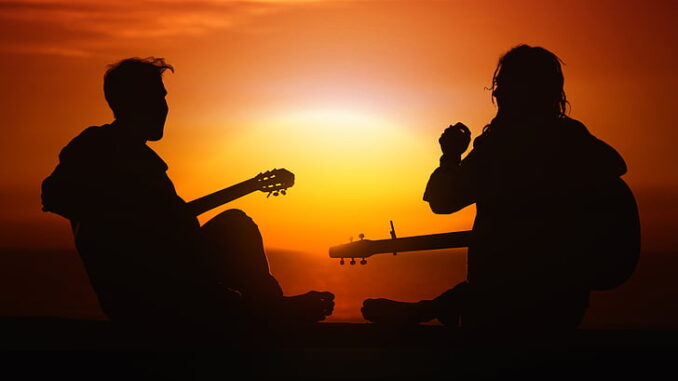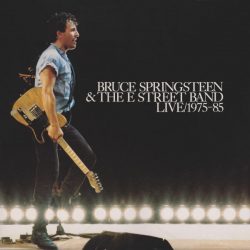
Rick Bayles, Editor of the Unsung Heroes series writes: “The Fender brand is 75 years old this year (founded in Fullerton, California in 1946). For this week’s look at Unsung Heroes of Americana, Tim Martin takes a look at Fender’s iconic Telecaster electric guitar, itself a sprightly 70 years young…”
Some designs are so perfect right from the start that there is simply no way to improve on them. The Fender Telecaster has been in production continuously since 1950. How has a basic slab of wood with a bit of bent metal for a bridge and the simplest electrics been able to hold a place in players’ hearts for so long?
While the later Stratocaster model has become ubiquitous, with pretty much every second guitarist using one at some point, the Tele’ has become the choice for many players seen as “technical” guitarists. Outside our part of the musical forest Andy Summers, Prince, and Bill Frisell are all recognised as virtuosos in their genres. Closer to home, Danny Gatton played a Tele’ almost exclusively, and many of the Band’s albums feature Robbie Robertson’s distinctive Telecaster sound.
 Many female guitarists are Tele’ players. Lucinda Williams, for example, has a particularly cool selection of Telecasters at her disposal. Emmylou Harris, better known for her acoustic work with a Gibson J200, was also known to pick up her guitarist James Burton’s Paisley Tele’. While Gibson are the acoustic of choice in roots circles, Fender’s Telecaster has long been the favourite electric guitar in Americana. The combination of image, robust construction, reliability on the road, and the versatile sound in the hands of the right player has endeared the Tele to all sorts of roots music players. While that signature Telecaster sound always has a distinctive twang at its heart, each player manages to bring their own feel to their playing. A Stratocaster always seems to sound like a Stratocaster, but a Tele, which in the hands of Albert Lee has a cleanly picked country sound, is a completely different instrument when played by the Mikes Bloomfield or Campbell. They make great rhythm guitars. Wilko Johnson is the master of the Telecaster chug, while Steve Cropper’s rhythm style is much crisper.
Many female guitarists are Tele’ players. Lucinda Williams, for example, has a particularly cool selection of Telecasters at her disposal. Emmylou Harris, better known for her acoustic work with a Gibson J200, was also known to pick up her guitarist James Burton’s Paisley Tele’. While Gibson are the acoustic of choice in roots circles, Fender’s Telecaster has long been the favourite electric guitar in Americana. The combination of image, robust construction, reliability on the road, and the versatile sound in the hands of the right player has endeared the Tele to all sorts of roots music players. While that signature Telecaster sound always has a distinctive twang at its heart, each player manages to bring their own feel to their playing. A Stratocaster always seems to sound like a Stratocaster, but a Tele, which in the hands of Albert Lee has a cleanly picked country sound, is a completely different instrument when played by the Mikes Bloomfield or Campbell. They make great rhythm guitars. Wilko Johnson is the master of the Telecaster chug, while Steve Cropper’s rhythm style is much crisper.
The cover of ‘Born to Run’ features Springsteen holding the Telecaster that he has played for much of his career. Although for guitar fans it is  actually a single pickup Esquire model, with an extra pickup and all sorts of other modifications; it looks perfect, uncomplicated, and cool. It’s the instrument that reinforced the image of the guitarist as the modern-day cowboy, with just his six-gun (or blond/black Telecaster) to hold off the world. Springsteen pulls this off to perfection on the cover of ‘Live/1975–85’.
actually a single pickup Esquire model, with an extra pickup and all sorts of other modifications; it looks perfect, uncomplicated, and cool. It’s the instrument that reinforced the image of the guitarist as the modern-day cowboy, with just his six-gun (or blond/black Telecaster) to hold off the world. Springsteen pulls this off to perfection on the cover of ‘Live/1975–85’.
As a key influence on many Americana musicians, James Burton cemented the Telecaster’s reputation along with his own. He used a 1952 model until he was presented with a Paisley Pink model when he worked with Elvis in the late 60s. Starting out with Ricky Nelson in the early 50s and going on to play with artists such as Gram Parsons, Rodney Crowell, and Emmylou Harris, as well as Elvis Presley, his Hall of Fame induction reads: “Burton has a well-deserved reputation as one of the finest guitar pickers in either country or rock.” Albert Lee, who succeeded Burton in Emmylou Harris’ Hot Band says “In the ’60s, Jimmy Page and I used to get together at my place or his and just roll on the floor listening to records. He was a Burton fan too and carried a picture of James in his wallet.”

The Telecaster, while a simple construction in itself, is perfectly suited to adaptation, and a number of variations have been incorporated into the basic design over the years. The Thinline Telecaster, which uses a chambered body to provide a more open tone and the Telecaster Deluxe and Customs, featuring humbucking pick-ups to cancel out the noise often associated with early single coil pickups. These have a more rounded Gibson-like tone. Perhaps one of the most interesting additions to the Telecaster is the B-Bender. This is a device used to change the B string’s pitch to a C# at the press of a lever located on the guitar strap peg. Byrds members Clarence White and Gene Parsons developed this to imitate the sound of a pedal steel guitar. It was taken up by Fender who marketed a Telecaster equipped with the B-Bender for some years. The Telecaster has always been a great base for modification and these examples are just a few of the many custom variants made by Fender and other companies. Its lightweight and smaller body size also make it ideal for those of us not over blessed in the stature department.
As a final piece of proof of its credibility, Dylan was playing a Telecaster when someone shouted “Judas” at him. I make no apology for the last of the videos below not being even remotely Americana-related. But as the man says, if you want to hear what a Telecaster, or in fact any electric guitar, should sound like in the hands of a master, listen to this…



Great informative article . But hmmmm , no mention of the great Bill Kirchen — “The Titan of the Telecaster” !
If the late, great Danny Gatton gets mentioned…then so should the late, great Leroy Buchanan also.
https://www.vintageguitar.com/2817/roy-buchanan/
Thanks for the link to the Roy Buchanan article too Kerry
Agreed – excellent article – I think I even understand what a hum-bucking pick up is now!